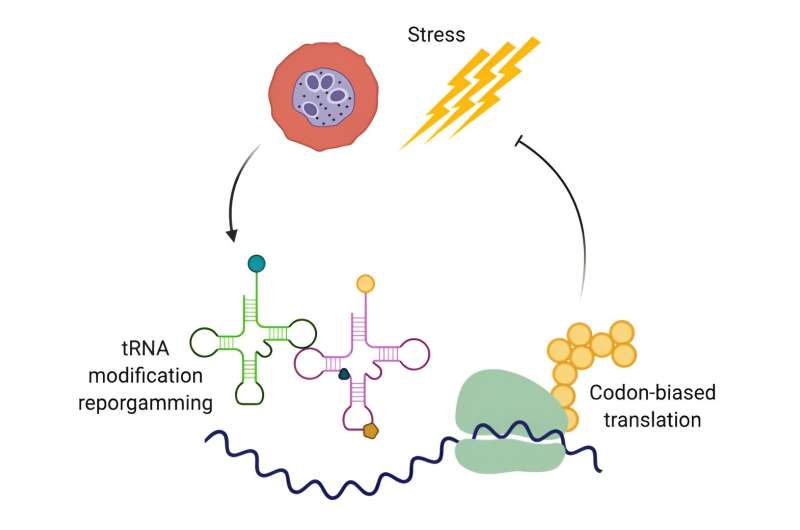This article has been reviewed according to Science X's editorial process and policies. Editors have highlighted the following attributes while ensuring the content's credibility:
fact-checked
peer-reviewed publication
trusted source
proofread
Research identifies mechanism behind drug resistance in malaria parasite

Collaborating researchers have discovered a link between malaria parasites' ability to develop resistance to antimalarial drugs—specifically artemisinin (ART)—through a cellular process called transfer ribonucleic acid (tRNA) modification. tRNA modification is a mechanism that allows cells to respond rapidly to stress by altering RNA molecules within a cell.
This discovery advances the understanding of how malaria parasites respond to drug-induced stress and develop resistance and paves the way for the development of new drugs to combat resistance.
Malaria is a mosquito-borne disease that afflicted 249 million people and caused 608,000 deaths globally in 2022. ART-based combination therapies, which combine ART derivatives with a partner drug, are first-line treatments for patients with uncomplicated malaria.
The ART compound helps to reduce the number of parasites during the first three days of treatment, while the partner drug eliminates the remaining parasites. However, Plasmodium falciparum (P. falciparum), the deadliest species of Plasmodium that causes malaria in humans, is developing partial resistance to ART. This partial resistance is widespread across Southeast Asia and has now been detected in Africa.
In a paper titled "tRNA modification reprogramming contributes to artemisinin resistance in Plasmodium falciparum", published in Nature Microbiology, researchers from the Antimicrobial Resistance Interdisciplinary Research Group at Singapore-MIT Alliance for Research and Technology (SMART), MIT's research enterprise in Singapore, in collaboration with Massachusetts Institute of Technology (MIT), Columbia University Irving Medical Center, and Nanyang Technological University, Singapore, document the novel discovery—a change in a single tRNA, a small RNA molecule that is involved in translating genetic information from RNA to protein, provides the malaria parasite with the ability to overcome drug stress.
The study describes how tRNA modification can alter the parasite's response to ART and help it survive ART-induced stress by changing its protein expression profile, making the parasite more resistant to the drug. ART partial resistance causes a delay in the eradication of malaria parasites following treatment with ART-based combination therapies, making these therapies less effective and susceptible to treatment failure.
"Malaria's growing drug resistance to artemisinin, the current last-line antimalarial drug, is a global crisis that demands new strategies and therapeutics. The mechanisms behind this resistance are complex and multifaceted, but our study reveals a critical link. We found that the parasite's ability to survive a lethal dose of artemisinin is linked to the downregulation of a specific tRNA modification. This discovery paves the way for new strategies to combat this growing global threat," said Jennifer L. Small-Saunders, Assistant Professor of Medicine in the Division of Infectious Diseases at CUIMC and first author of the paper.
The researchers investigated the role of epitranscriptomics—the study of RNA modifications within a cell—in influencing drug resistance in malaria by leveraging the advanced technology and techniques for epitranscriptomic analysis developed at SMART. This involves isolating the RNA of interest, tRNA, and using mass spectrometry to identify the different modifications present.
They isolated and compared the drug-sensitive and drug-resistant malaria parasites, some of which were treated with ART and others left untreated as controls. The analysis revealed changes in the tRNA modifications of drug-resistant parasites, and these modifications were linked to the increased or decreased translation of specific genes in the parasites.
The altered translation process was found to be the underlying mechanism for the observed increase in drug resistance. This discovery also expands our understanding of how microbes and cancer cells exploit the normal function of RNA modifications to thwart the toxic effects of drugs and other therapeutics.
"Our research, the first of its kind, shows how tRNA modification directly influences the parasite's resistance to ART, highlighting the potential impact of RNA modifications on both disease and health. While RNA modifications have been around for decades, their role in regulating cellular processes is an emerging field. Our findings highlight the importance of RNA modifications for the research community and the broader significance of tRNA modifications in regulating gene expression," said Peter Dedon, Co-Lead Principal Investigator at SMART AMR, Professor at MIT and one of the authors of the paper.
"At SMART AMR, we're at the forefront of exploring epitranscriptomics in infectious diseases and antimicrobial resistance. Epitranscriptomics is an emerging field in malaria research and plays a crucial role in how malaria parasites develop and respond to stress," said Peter Preiser, Co-Lead Principal Investigator at SMART AMR, Professor of Molecular Genetics & Cell Biology at NTU Singapore and one of the authors of the paper.
"This discovery reveals how drug-resistant parasites exploit epitranscriptomic stress response mechanisms for survival, which is particularly important for understanding parasite biology."
The research sets the foundation for the development of better tools to study RNA modifications and their role in resistance while simultaneously opening new avenues for drug development. RNA-modifying enzymes, especially those linked to resistance, are currently understudied, and they are attractive targets for the development of new and more effective drugs and therapies.
By hindering the parasite's ability to manipulate these modifications, drug resistance can be prevented from arising. Researchers at SMART AMR are actively pursuing the discovery and development of small molecule and biological therapeutics that target RNA modifications in viruses, bacteria, parasites, and cancer.
More information: Jennifer L. Small-Saunders et al, tRNA modification reprogramming contributes to artemisinin resistance in Plasmodium falciparum, Nature Microbiology (2024). DOI: 10.1038/s41564-024-01664-3
Journal information: Nature Microbiology



















